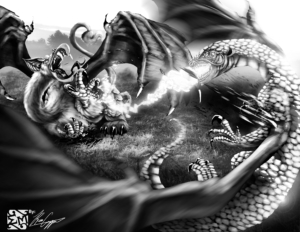
Lyvulseroptera
Illustration by Epic Made
First, [Rafe] Cassius decided to recreate the legendary gryphon. From this exercise in frustration spewed forth many bizarre creatures.… Eventually, the genes of a vulture were spliced into the genome of a lynx to create a creature similar to a gryphon. Adding bat genes shouldn’t be a problem, Rafe thought. Many a failed experiment corrected this misapprehension…. His next exercise was to splice the genes of a spitting viper into his creature. This took a while. Finally, copious amounts of poisonous saliva drooled from his creature’s mouth ‒ not quite what he had in mind.
The lyvulseroptera (lī-vul-ser-ŏp-ter-a) was a bizarre being. It had the sharp pointed nose and ears of a bat, a bat’s forehead, and the inverted wings of a bat. It had the eyes of the lynx, the tongue and fangs of a viper, and the beak of a vulture. It also had a long slender neck, akin to the body of a snake. It retained the hind legs and tail of a lynx and the forelegs and talons of the vulture.
(Excerpt from Homo transformans: The Origin and nature of the Species)
Chimera
In Greek mythology, the chimera was a fire-breathing creature with the head of a lion, the body of a goat, and the tail of a serpent. In genetics, chimerism refers to two genetically distinct population of cells within a single individual (Bottega, et al., 2019; Chen, et al., 2013; Tavares, et al., 2018). This can result when two genetically different fertilized eggs fuse together, which can occur in fraternal (dizygotic) twins (Peters, et al., 2017; Tavares, et al., 2018). Chimerism is most often found in offspring with multiple sex chromosome genotypes such as 46,XX/46,XY (Choi, et al., 2019). Chimerism is also encountered as a result of bone marrow transplantation from a non identical (allogeneic) donor (Waterhouse, et al., 2019).
In the novels Homo transformans: The Origin and Nature of the Species and H’Ilgraith, human and animal hybrids are essentially chimeras. Their genomes were implanted with the genes of one or more other species of animals with malevolent intent. For the animal hybrids, the genes were implanted into a fertilized egg or embryo. The embryo was allowed to develop, although only a few did. In people who were Homo transformans, the genes were delivered by a viral vector. The victim was subsequently forced to transform – usually with lethal consequences.
Creative Collaboration
I worked closely with the graphic artists of Epic Made to create the creatures found in my novels. I would provide a description of the creature or scene. The artists at Epic Made would craft an initial sketch, and we would work from there. We would discuss changes via telephone conference call or via email correspondence. Over time, I learned to provide more detail and include the scenario in which the character appeared. In turn, the artists provided recommendations for how an image should be oriented – especially, in an action scene painting – and the rationale.
With the exception of dragons, the majority of the images of hybrids are unique. The cercopithsurid https://dribbble.com/shots/7274556-Human-Hybrid-03 is an example of a hybrid humanoid. The lyvulfon https://dribbble.com/shots/7155218-Lyvulfon is an example of an animal hybrid. Although the baseline is either a human or an animal species, the features of some of the characters are quite complex ‒ especially, those of Rafe Cassius https://dribbble.com/shots/7276617-Human-Hybrid-01 and the lyvulseroptera https://dribbble.com/shots/7154560-Lyvulseroptera. Additional illustrations by Epic Made – including scenes of wildlife – can be viewed at www.maryames.org/sneak-peeks/.
References
Bottega, R., Cappellani, S., Fabretto, A., et al. (2019). Could a chimeric condition be responsible for unexpected genetic syndromes? The role of the single nucleotide polymorphism-array analysis. Molecular genetics & genomic medicine, 7(3), e546. doi:10.1002/mgg3.546.
Chen K, Chmait RH, Vanderbilt D, Wu S, Randolph L.(2013). Chimerism in monochorionic dizygotic twins: case study and review. Am J Med Genet A, 161A(7): 1817-24.
Choi, E. J., Kim, S. R., Kim, Y. J., et al. (2019). Clinical and Genetic Analysis of an Infertile Male with 46,XX/46,XY Chimerism. Andrologia. 51(3):e13215. doi: 10.1111/and.13215.
Peters, H. E., König, T. E., Verhoeven, M. O., et al. (2017). Unusual Twinning Resulting in Chimerism: A Systematic Review on Monochorionic Dizygotic Twins. Twin Res Hum Genet, 20(2), 161-168.
Tavares, L. Da Costa, D. C., Batshauer, A. P. B., et al. (2018). Blood chimerism in twins. Immunohematology, 34(4), 151-157.
Waterhouse, M., Pfeifer, D., Duque-Afonso, J., et al. (2019). Droplet digital PCR for the simultaneous analysis of minimal residual disease and hematopoietic chimerism after allogeneic cell transplantation. Clin Chem Lab Med, 57(5), 641-647. doi: 10.1515/cclm-2018-0827.